By Keith Austin
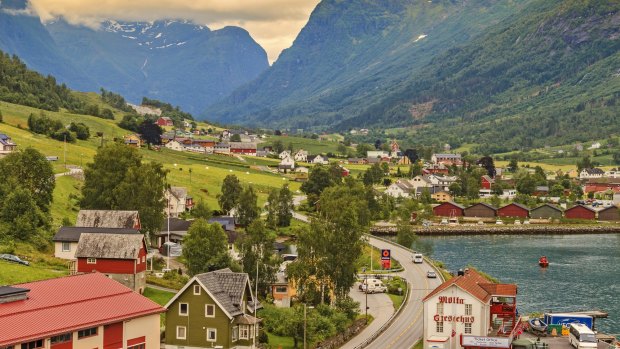
The stunning village Of Olden.Credit: Alamy
Trolls are big in Norway. There are trolls on T-shirts, fridge magnets, tea towels, mugs, you name it. There's usually a small one with a big nose standing guard outside souvenir shops in which troll statues and troll dolls abound.
And here we are at the Bergen quayside food market where a red-bearded stallholder is waving a large brown sausage in my direction. It's not a threatening gesture by any means – there's a lot of it going on here – but he does seem perplexed.
On the label of the vacuum-packed salami, which he picked out of a neat pile of moose and whale sausages, is a drawing of, you guessed it, a troll.
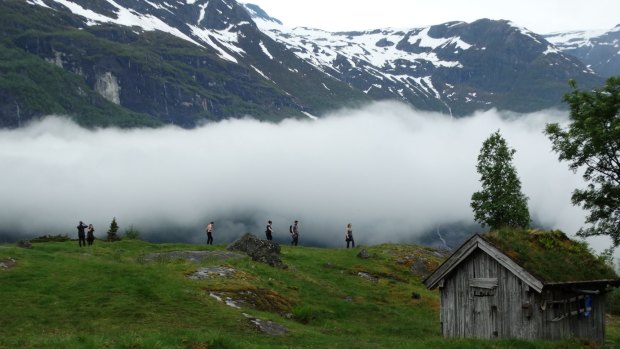
Mountains bursting through the clouds.Credit: Keith Austin
"Is it real troll meat?" I ask him again. "I've been in Norway for four days and I haven't seen one troll. It's very frustrating. Do you farm them?"
I suspect something has been lost in translation until, eventually, a large gap opens up in the hedgerow that obscures his lower face. It's either a smile or a pre-sausaged moose is going to come charging out.
"It's really just pork and bits of other stuff," he whispers in that lovely Norwegian accent which makes everything sound like a drunk barber shop quartet warming up. "Very popular with Norwegians just before Christmas."
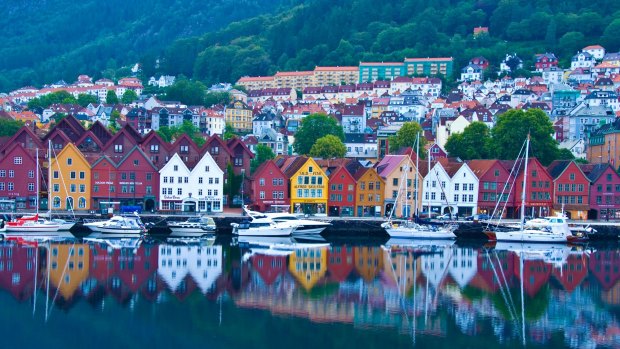
Bergen waterfront, is a UNESCO World Heritage Site.Credit: Alamy
We are on day five of a short cruise on the Emerald Princess, a ship which will make its Australian debut in November this year but which for the time being is slumming it in the Norwegian fjords.
We've already ticked off Stavanger, Olden and Skjolden, and are in Bergen for a few hours before setting off back to Southampton. To be perfectly honest Stavanger, Olden and Skjolden could have been The Three Norwegian Stooges for all I knew about them beforehand but it's surprising what you can find there (not trolls, obviously, but let's not dwell on that).
Stavanger, which we came upon after a full day steaming up the North Sea, is a small city of 132,000 people at the southern end of Norway's confusing and bronchiole-like western coastline. It has a harbour deep enough for a ship holding 4200 passengers and crew. This means we can park (yes, yes, moor) right in the centre of town not far from the small lake supposedly created when a troll – essentially Norway's leprechauns but bigger and uglier – launched a boulder at the new cathedral in 1125 and missed.
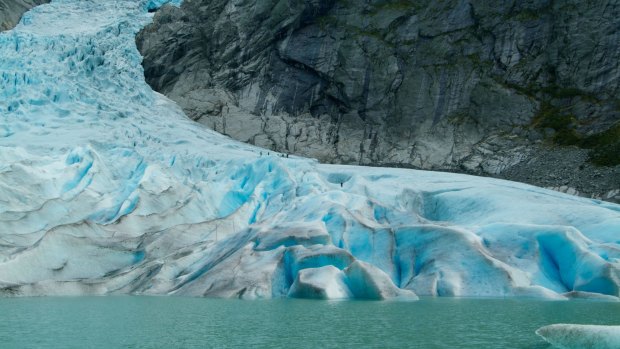
A glacial blue lake at the bottom of the Briksdalbreen Glacier.Credit: Alamy
Just outside Stavanger, if you like that sort of thing, is a 360-degree lookout on a hill and a faithful reconstruction of an Iron Age farm where locals dressed in Iron Age furs explain what life was like back then (cold, brutish and curiously devoid of trolls, given they were hurling boulders around the place).
The more modern part of town itself is pretty once you get away from the municipal centre, with narrow, winding streets full of twee cafes, restaurants and shops. The main attraction, though, is the lovely old town (Gamle Stavanger) on the other side of the harbour.
With its cobblestoned streets and white weatherboard houses it really is quite beautifully preserved and, apart from all the gaggles of tourist groups, not at all touristy. There are a few shops, the Norwegian Canning Museum (I kid you not) and, glimpsed through the gaps in the homes, a bloody great big ship towering incongruously over the pretty tiled ochre roofs. Yes, we were that close.
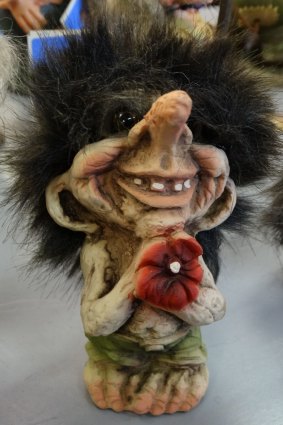
Troll doll.Credit: Keith Austin
We cruised out as the sun started to set and headed off to Olden (population about 1600) where, the next morning, we awoke to a jaw-dropping backdrop of snow-capped mountains, waterfalls tumbling down sheer cliffs and red hillside houses and pine trees wreathed in mist. Just looking at it made me think "troll country for sure".
After a fortifying breakfast we joined the excursion to Brenndalsbreen and Briksdalbreen, which turned out to be a couple of glaciers and not the troll husband-and-wife team I had been expecting (memo to self, read the literature properly).
At the first glacier we hiked into the woods and for an hour, accompanied by birdsong and the wet muttering of waterfalls, following meandering, medium-sized inclines to a solitary mountain hut from where you can see Brenndalsbreen as it inches icily down a hillside (or retreats up it, as they all seem to be doing these days). And it was here that I discovered the troll bridge.
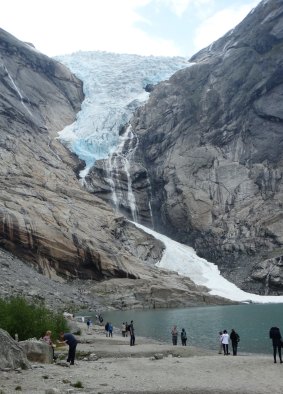
Glaciers inch icily down a hillside.Credit: Keith Austin
Most passengers were content to stop at the hut and take selfies of themselves with the glacier in the background but a few hardy souls kept going, determined to get as close as possible. The path led down to a small cul-de-sac field dotted with incurious goats but as we got there the clouds which had dogged us all day closed in and obscured the view.
It was on the way back that I spotted a small pathway off to the right and decided to follow it; the path less travelled and all that. And what did I find but a higgledy-piggledy wooden bridge over a fairly swift river of bubbling, milk-coloured glacier water. And, my friends, if that wasn't a troll bridge then my name's Arne Saknussemm (Journey to the Centre of the Earth, if anyone's interested).
I peeked under the bridge. Nothing. I stood there and made troll noises … to no avail. Perhaps it was troll vacation time. Somewhat like Britain at that very moment, which I could only imagine was empty of schoolchildren because they were all on our ship intent on getting into the Guinness Book of Records for the most number of people crammed into soupy whirlpool baths.
Brenndalsbreen, by the way, is the lesser of these two glaciers. You can tell because Google keeps coughing up Briksdalbreen when you enter "Brenndalsbreen". It's sort of the Andrew Ridgeley of glaciers, packing just that little less of a wham than its more talented partner.
This is because Briksdalbreen is impressive; a pale-blue frozen wave of snow which looks like it tipped over the edge of a crevasse and changed its mind halfway down. Below it is a clear, ice-cold lake in which bob fist-sized snowballs of ice. And the best bit is just how close you can get. Though there is an egregious lack of troll bridges.
On the third day of the cruise we arrived in the tiny village of Skjolden (pop. 200 or so), at the very end of the Lustrafjorden, itself a branch of the Sognefjorden, Norway's longest and deepest fjord. (Do not try to read that last paragraph out loud unless you are Norwegian or have a double-jointed tongue.)
Our guide for the bus tour was Lars who, despite his laconic delivery, was a veritable mine of information. As we began to climb the switchbacks up and away from the ship he entertained us with tales of Satanists burning old churches in the 1990s, how Henrik Ibsen was stuck in a hut for three days by a blizzard on the plateau to which we were headed and how, of the 80,000 registered hunters in Norway, only 12 per cent are women. Nothing, sadly, about trolls.
As we motored higher the green of the lower reaches gave way to an almost black-and-white world of dark vegetation and snow patches punctuated here and there by eerily turquoise pools of near-frozen glacier water.
At the highest point of the plateau we stopped for a moment at a monument to Ibsen and went to great lengths to take photographs showing the desolate nature of the place without including the three tour buses, the minivan and the two cars in the layby.
The road we were on, said Lars when we were back in the bus, was pretty much impassable during the winter months and would be piled high with nine metres of snow when the plough finally broke through in spring.
After what seemed to be the obligatory lunch of potato, dill sauce and excellent salmon (pronounced "sal-mon" by the locals) in the Fossheim restaurant in Lom we headed over a forceful river to one of the ancient timber stave churches that escaped the arsonists. Frankly, whatever beef you have with God, you'd have to be an idiot to want to burn down one of these beauties.
The Lom church is among the oldest wooden buildings in the world still in use – it dates from the second half of the 12th century though sections were added during the 17th century. It is one of the biggest and, supposedly, most handsome in Norway. Built entirely of local pine and tarred against the weather every six or seven years it's one of the few edifices that both looks and smells good.
Inside and out it was a revelation, a lovingly put together timber building decorated with a combination of Christian and pre-Christian motifs and carvings. A tour guide gave us a short lecture on the church and its history, even pointing to some runes high up in the rafters which simply say something along the lines of "Ulf was here".
It was the highlight of the trip until the encounter with the market and the troll sausage in shockingly beautiful Bergen, Norway's second largest city.
Quite apart from the rightly famous vibrantly coloured houses of the Bryggen (wharf), the quayside market is a cornucopia of sights and sounds and smells, a feast for the senses.
Here, among signs in Norwegian, English, Japanese and Chinese, you can sit at tables and scoff down yet more sal-mon or stock up on caviar, herring, kippers, eel, crab, moose salami and dried codfish. You can also taste test whale (minke if you must know). It's a bit like fishy steak and it'll never catch on. Not like troll.
TRIP NOTES
MORE INFORMATION
GETTING THERE
British Airways, Qantas and most other major airlines fly direct to London from the main Australian cities. Visit webjet.com.au for details.
THE CRUISE
While the Emerald Princess will be locating to Australia in November, the Crown Princess will take over the Norway fjord route in 2017. Prices for interior staterooms start from $2059 a person twin share (taxes, fees and port expenses included). Fares include motor coach transfer from London to Southampton and return. For more information and bookings see a licensed travel agent, visit princess.com or call Princess Cruises on 13 24 88.
THE TOURS
Many of the shore excursions on Princess Cruises globally have a Discovery Channel tick of approval, part of a new partnership between the cruise line and Discovery. These include the Stavanger Iron Age Farm shore excursion.
Official excursions from the ship cost extra. Day tours are priced from $159.95 and include all admission prices and lunch. Half day tours cost $79.95. Advance bookings are recommended.
Keith Austin travelled as a guest of Princess Cruises.
Sign up for the Traveller Deals newsletter
Get exclusive travel deals delivered straight to your inbox. Sign up now.